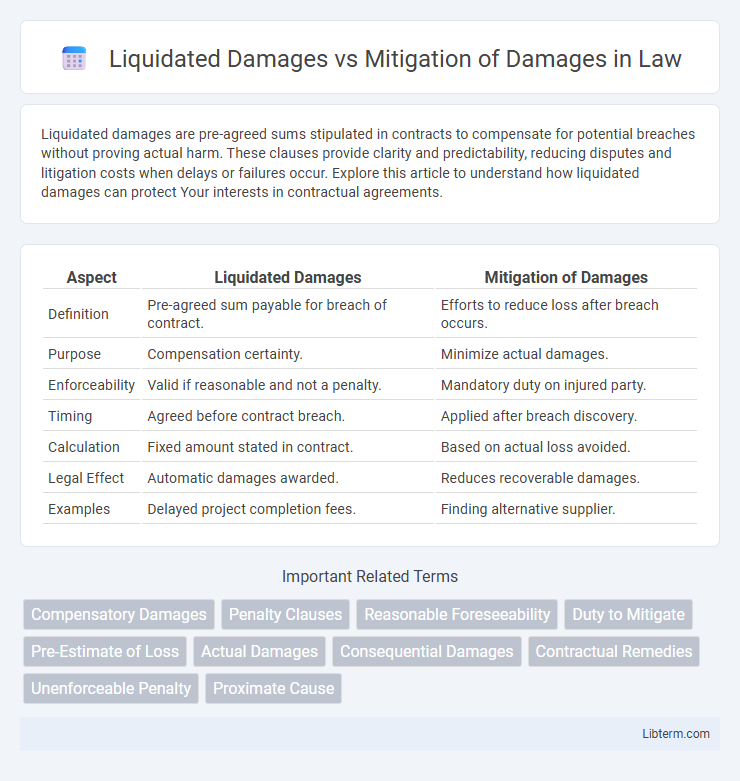Liquidated damages are pre-agreed sums stipulated in contracts to compensate for potential breaches without proving actual harm. These clauses provide clarity and predictability, reducing disputes and litigation costs when delays or failures occur. Explore this article to understand how liquidated damages can protect Your interests in contractual agreements.
Table of Comparison
| Aspect | Liquidated Damages | Mitigation of Damages |
|---|---|---|
| Definition | Pre-agreed sum payable for breach of contract. | Efforts to reduce loss after breach occurs. |
| Purpose | Compensation certainty. | Minimize actual damages. |
| Enforceability | Valid if reasonable and not a penalty. | Mandatory duty on injured party. |
| Timing | Agreed before contract breach. | Applied after breach discovery. |
| Calculation | Fixed amount stated in contract. | Based on actual loss avoided. |
| Legal Effect | Automatic damages awarded. | Reduces recoverable damages. |
| Examples | Delayed project completion fees. | Finding alternative supplier. |
Introduction to Liquidated Damages
Liquidated damages represent a pre-agreed sum specified in a contract, designed to compensate the non-breaching party for losses resulting from a breach, particularly when actual damages are difficult to quantify. This contractual provision provides certainty and expedites dispute resolution by establishing a fixed financial consequence for delay or non-performance. Courts typically enforce liquidated damages clauses when the amount is reasonable and not punitive, contrasting with mitigation of damages, which requires the injured party to minimize losses after a breach occurs.
Defining Mitigation of Damages
Mitigation of damages requires the injured party to take reasonable steps to reduce the loss resulting from a breach of contract, minimizing further harm or expenses. This principle ensures claimants cannot recover damages that could have been avoided through ordinary care or effort. Unlike liquidated damages, which are predetermined contractually, mitigation of damages is a reactive strategy focused on limiting actual losses after a breach occurs.
Key Differences Between Liquidated and Mitigation of Damages
Liquidated damages are predetermined amounts agreed upon in a contract to be paid if a breach occurs, providing certainty and avoiding lengthy litigation. Mitigation of damages requires the injured party to take reasonable steps to reduce or limit their losses after a breach, ensuring that damages are not unnecessarily inflated. The key difference lies in liquidated damages being fixed and agreed upfront, while mitigation involves actively minimizing actual losses post-breach.
Legal Principles Underpinning Liquidated Damages
Liquidated damages clauses establish a predetermined sum payable upon contract breach, reflecting a genuine pre-estimate of loss to avoid protracted damage calculations. The legal principle underpinning liquidated damages requires the amount to be a reasonable forecast of probable damages, not a penalty designed to punish the breaching party. Courts enforce these clauses when the stipulated sum aligns with the anticipated harm and the actual damages are difficult to quantify, ensuring fair compensation without unjust enrichment.
The Duty to Mitigate Damages Explained
The duty to mitigate damages requires the injured party to take reasonable steps to minimize losses after a breach of contract, ensuring damages awarded are not excessive. Liquidated damages are predetermined amounts specified in a contract, agreed upon as fair compensation if a breach occurs, and do not depend on actual harm or mitigation efforts. Understanding this distinction is crucial, as failure to mitigate can reduce recoverable damages, whereas liquidated damages are enforceable regardless of mitigation.
Common Contractual Clauses on Liquidated Damages
Common contractual clauses on Liquidated Damages specify a predetermined amount payable upon breach, aiming to provide certainty and avoid protracted damage assessments. They differ from Mitigation of Damages, which requires the non-breaching party to take reasonable steps to minimize losses after a breach occurs. These clauses are typically enforceable when the liquidated amount is a genuine pre-estimate of loss rather than a penalty.
When Are Liquidated Damages Enforceable?
Liquidated damages are enforceable when the amount is a reasonable estimate of actual harm anticipated at contract formation, not a penalty. Courts typically uphold liquidated damages clauses if damages are difficult to measure and the stipulated sum reflects genuine pre-estimation of loss. Mitigation of damages requires the injured party to take reasonable steps to reduce loss, but does not affect the enforceability of a valid liquidated damages provision.
Mitigation Obligations: Responsibilities of the Injured Party
Mitigation of damages requires the injured party to take reasonable steps to minimize loss after a breach of contract, including seeking alternative solutions or remedies. Failure to fulfill mitigation obligations can reduce the amount of recoverable damages, as courts examine the injured party's proactive efforts. These responsibilities balance fairness by preventing unnecessary escalation of losses and encouraging prompt resolution.
Case Studies: Liquidated Damages vs. Mitigation Scenarios
Case studies comparing liquidated damages and mitigation of damages highlight distinct contractual and judicial approaches to breach consequences. In scenarios enforcing liquidated damages, courts emphasize pre-agreed sums reflecting anticipated harm, as seen in *British Westinghouse Electric Co Ltd v Underground Electric Railways Co of London Ltd*, ensuring predictability but strict adherence to contract terms. Conversely, mitigation cases like *Jarvis v Swans Tours Ltd* demonstrate judicial willingness to reduce awards based on the claimant's efforts to minimize losses, underscoring the principle that damages should reflect actual harm rather than punitive sums.
Practical Considerations for Drafting Contracts
When drafting contracts, liquidated damages clauses require a reasonable estimation of potential losses to ensure enforceability, avoiding penalties that courts may reject. Mitigation of damages emphasizes the injured party's duty to take reasonable steps to minimize losses, influencing the allocation of risk and responsibilities in contract terms. Including clear obligations and remedies related to both liquidated damages and mitigation fosters balanced risk management and reduces litigation risks.
Liquidated Damages Infographic

 libterm.com
libterm.com